stop start KIA Sorento 2007 1.G User Guide
[x] Cancel search | Manufacturer: KIA, Model Year: 2007, Model line: Sorento, Model: KIA Sorento 2007 1.GPages: 325, PDF Size: 5.01 MB
Page 211 of 325
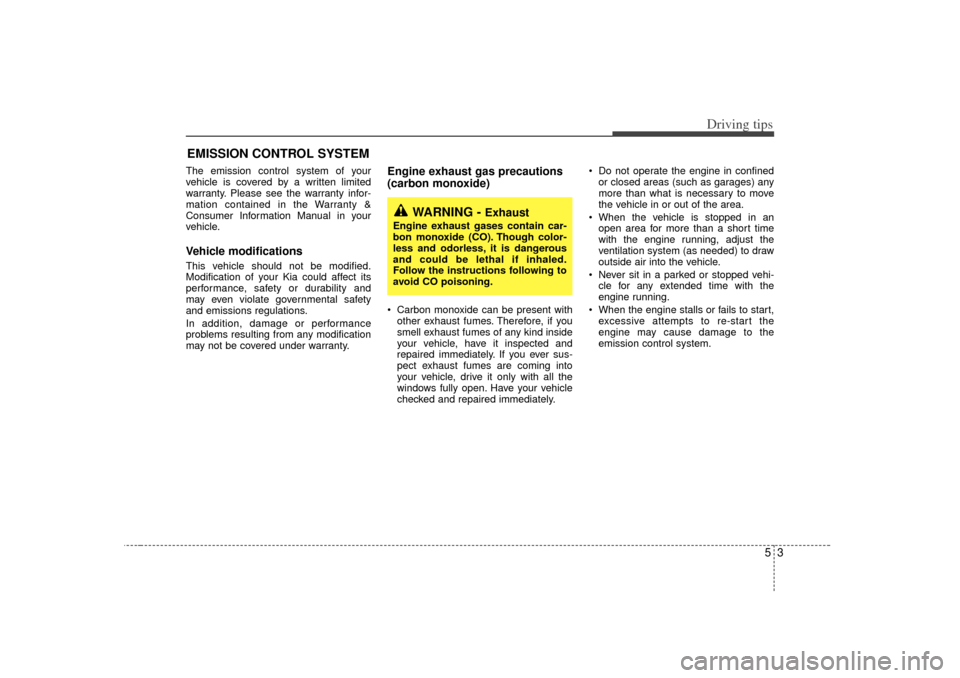
53
Driving tips
EMISSION CONTROL SYSTEMThe emission control system of your
vehicle is covered by a written limited
warranty. Please see the warranty infor-
mation contained in the Warranty &
Consumer Information Manual in your
vehicle.Vehicle modifications This vehicle should not be modified.
Modification of your Kia could affect its
performance, safety or durability and
may even violate governmental safety
and emissions regulations.
In addition, damage or performance
problems resulting from any modification
may not be covered under warranty.
Engine exhaust gas precautions
(carbon monoxide) Carbon monoxide can be present withother exhaust fumes. Therefore, if you
smell exhaust fumes of any kind inside
your vehicle, have it inspected and
repaired immediately. If you ever sus-
pect exhaust fumes are coming into
your vehicle, drive it only with all the
windows fully open. Have your vehicle
checked and repaired immediately. Do not operate the engine in confined
or closed areas (such as garages) any
more than what is necessary to move
the vehicle in or out of the area.
When the vehicle is stopped in an open area for more than a short time
with the engine running, adjust the
ventilation system (as needed) to draw
outside air into the vehicle.
Never sit in a parked or stopped vehi- cle for any extended time with the
engine running.
When the engine stalls or fails to start, excessive attempts to re-start the
engine may cause damage to the
emission control system.
WARNING -
Exhaust
Engine exhaust gases contain car-
bon monoxide (CO). Though color-
less and odorless, it is dangerous
and could be lethal if inhaled.
Follow the instructions following to
avoid CO poisoning.
Page 217 of 325
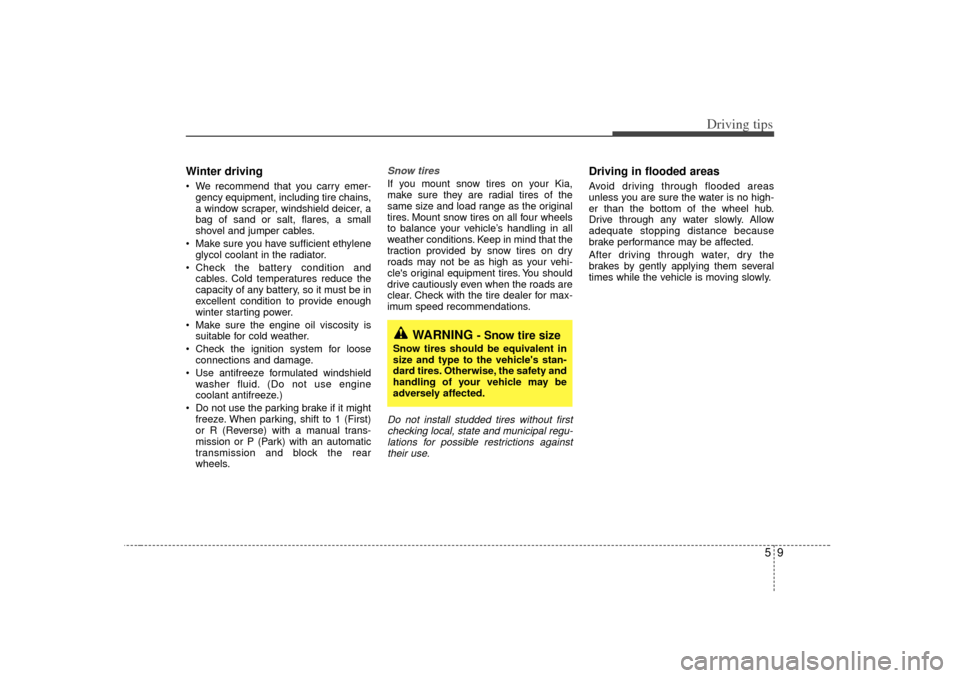
59
Driving tips
Winter driving We recommend that you carry emer-gency equipment, including tire chains,
a window scraper, windshield deicer, a
bag of sand or salt, flares, a small
shovel and jumper cables.
Make sure you have sufficient ethylene glycol coolant in the radiator.
Check the battery condition and cables. Cold temperatures reduce the
capacity of any battery, so it must be in
excellent condition to provide enough
winter starting power.
Make sure the engine oil viscosity is suitable for cold weather.
Check the ignition system for loose connections and damage.
Use antifreeze formulated windshield washer fluid. (Do not use engine
coolant antifreeze.)
Do not use the parking brake if it might freeze. When parking, shift to 1 (First)
or R (Reverse) with a manual trans-
mission or P (Park) with an automatic
transmission and block the rear
wheels.
Snow tires If you mount snow tires on your Kia,
make sure they are radial tires of the
same size and load range as the original
tires. Mount snow tires on all four wheels
to balance your vehicle’s handling in all
weather conditions. Keep in mind that the
traction provided by snow tires on dry
roads may not be as high as your vehi-
cle's original equipment tires. You should
drive cautiously even when the roads are
clear. Check with the tire dealer for max-
imum speed recommendations.Do not install studded tires without firstchecking local, state and municipal regu-lations for possible restrictions againsttheir use.
Driving in flooded areas Avoid driving through flooded areas
unless you are sure the water is no high-
er than the bottom of the wheel hub.
Drive through any water slowly. Allow
adequate stopping distance because
brake performance may be affected.
After driving through water, dry the
brakes by gently applying them several
times while the vehicle is moving slowly.
WARNING
- Snow tire size
Snow tires should be equivalent in
size and type to the vehicle's stan-
dard tires. Otherwise, the safety and
handling of your vehicle may be
adversely affected.
Page 224 of 325
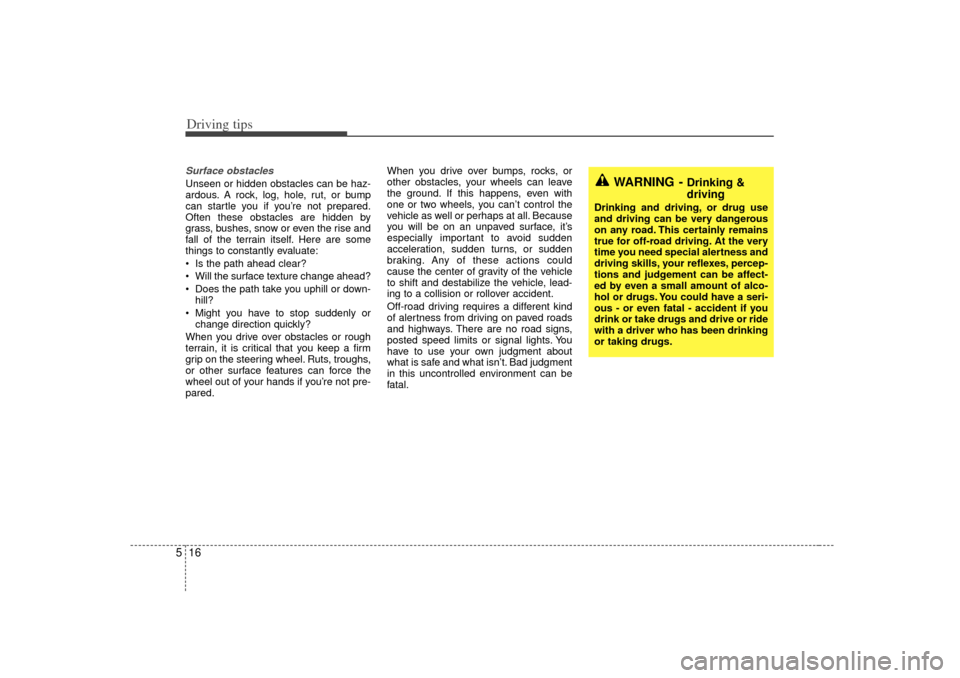
Driving tips16
5
WARNING -
Drinking &
driving
Drinking and driving, or drug use
and driving can be very dangerous
on any road. This certainly remains
true for off-road driving. At the very
time you need special alertness and
driving skills, your reflexes, percep-
tions and judgement can be affect-
ed by even a small amount of alco-
hol or drugs. You could have a seri-
ous - or even fatal - accident if you
drink or take drugs and drive or ride
with a driver who has been drinking
or taking drugs.
Surface obstaclesUnseen or hidden obstacles can be haz-
ardous. A rock, log, hole, rut, or bump
can startle you if you’re not prepared.
Often these obstacles are hidden by
grass, bushes, snow or even the rise and
fall of the terrain itself. Here are some
things to constantly evaluate:
Is the path ahead clear?
Will the surface texture change ahead?
Does the path take you uphill or down-
hill?
Might you have to stop suddenly or change direction quickly?
When you drive over obstacles or rough
terrain, it is critical that you keep a firm
grip on the steering wheel. Ruts, troughs,
or other surface features can force the
wheel out of your hands if you’re not pre-
pared. When you drive over bumps, rocks, or
other obstacles, your wheels can leave
the ground. If this happens, even with
one or two wheels, you can’t control the
vehicle as well or perhaps at all. Because
you will be on an unpaved surface, it’s
especially important to avoid sudden
acceleration, sudden turns, or sudden
braking. Any of these actions could
cause the center of gravity of the vehicle
to shift and destabilize the vehicle, lead-
ing to a collision or rollover accident.
Off-road driving requires a different kind
of alertness from driving on paved roads
and highways. There are no road signs,
posted speed limits or signal lights. You
have to use your own judgment about
what is safe and what isn’t. Bad judgment
in this uncontrolled environment can be
fatal.
Page 226 of 325
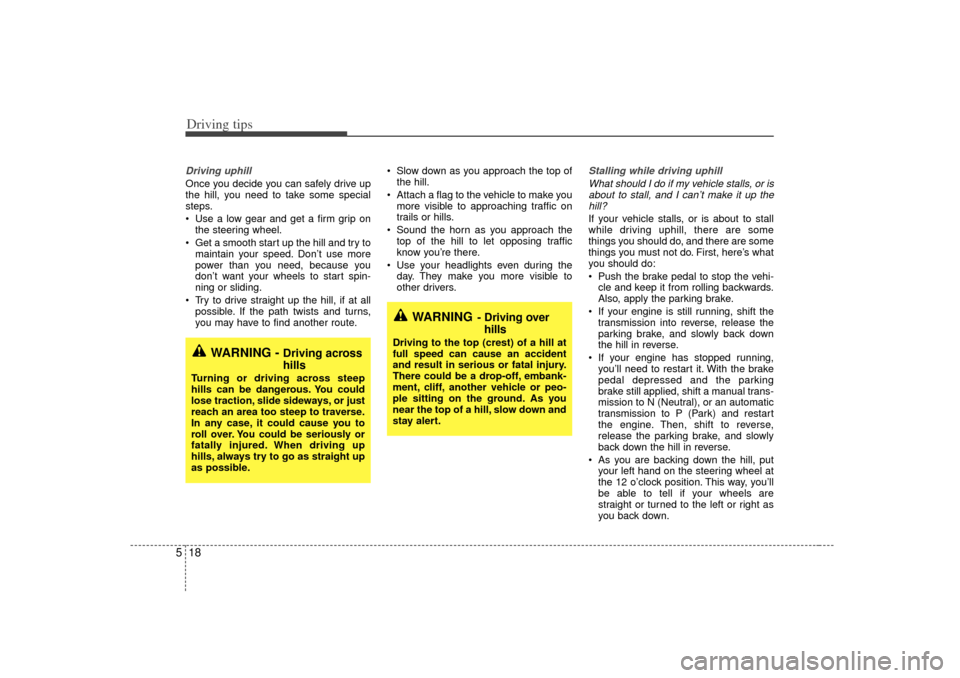
Driving tips18
5Driving uphillOnce you decide you can safely drive up
the hill, you need to take some special
steps.
Use a low gear and get a firm grip on
the steering wheel.
Get a smooth start up the hill and try to maintain your speed. Don’t use more
power than you need, because you
don’t want your wheels to start spin-
ning or sliding.
Try to drive straight up the hill, if at all possible. If the path twists and turns,
you may have to find another route. Slow down as you approach the top of
the hill.
Attach a flag to the vehicle to make you more visible to approaching traffic on
trails or hills.
Sound the horn as you approach the top of the hill to let opposing traffic
know you’re there.
Use your headlights even during the day. They make you more visible to
other drivers.
Stalling while driving uphill
What should I do if my vehicle stalls, or isabout to stall, and I can’t make it up thehill?If your vehicle stalls, or is about to stall
while driving uphill, there are some
things you should do, and there are some
things you must not do. First, here’s what
you should do:
Push the brake pedal to stop the vehi- cle and keep it from rolling backwards.
Also, apply the parking brake.
If your engine is still running, shift the transmission into reverse, release the
parking brake, and slowly back down
the hill in reverse.
If your engine has stopped running, you’ll need to restart it. With the brake
pedal depressed and the parking
brake still applied, shift a manual trans-
mission to N (Neutral), or an automatic
transmission to P (Park) and restart
the engine. Then, shift to reverse,
release the parking brake, and slowly
back down the hill in reverse.
As you are backing down the hill, put your left hand on the steering wheel at
the 12 o’clock position. This way, you’ll
be able to tell if your wheels are
straight or turned to the left or right as
you back down.
WARNING -
Driving across
hills
Turning or driving across steep
hills can be dangerous. You could
lose traction, slide sideways, or just
reach an area too steep to traverse.
In any case, it could cause you to
roll over. You could be seriously or
fatally injured. When driving up
hills, always try to go as straight up
as possible.
WARNING
- Driving overhills
Driving to the top (crest) of a hill at
full speed can cause an accident
and result in serious or fatal injury.
There could be a drop-off, embank-
ment, cliff, another vehicle or peo-
ple sitting on the ground. As you
near the top of a hill, slow down and
stay alert.
Page 229 of 325

521
Driving tips
Stalling downhillStalling is much more likely to happen
going uphill. But if it happens going
downhill, here’s what to do.
Stop your vehicle by applying thebrakes. Then apply the parking brake.
Move the shift lever to P (Park) in auto- matic transmission or shift to N
(Neutral) in manual transmission and,
while still braking, restart the engine.
Shift back to a low gear, release the parking brake, and drive straight down.
If the engine won’t start, get out and seek help. Exit on the uphill side of the
vehicle and stay clear of the path the
vehicle would take if it rolled downhill.
Driving across an inclineSooner or later, an off-road trail will prob-
ably go across the incline of a hill. If this
happens, you have to decide whether or
not to try to drive across the incline. Here
are some things to consider:
A hill that can be driven straight up ordown may be too steep to drive across.
When you go straight up or down a hill,
the length of the wheel base (the dis-
tance from the front wheels to the rear
wheels) reduces the likelihood the
vehicle will tumble end over end. But
when you drive across an incline, the
much narrower track width (the dis-
tance between the left and right
wheels) may not prevent the vehicle
from tilting and rolling over. Also, driv-
ing across an incline puts more weight
on the downhill wheels. This could
cause a downhill slide or a rollover.
Surface conditions can be a problem when you drive across a hill. Loose
gravel, muddy spots, or even wet grass
can cause your tires to slip sideways. If
the vehicle slips sideways, it can hit
something that will tip it (a rock, a rut,
etc.) and cause it to roll over. Hidden obstacles can make the steep-
ness of the incline even worse. If you
drive across a rock with the uphill
wheels, or if the downhill wheels drop
into a rut or depression, your vehicle
can tilt even more.
For reasons like these, you need to
decide carefully whether or not to try to
drive across an incline. Just because the
trail goes across the incline doesn’t
mean you have to drive it.
WARNING
- Roll over
Driving across an incline that’s too
steep will make your vehicle roll
over. You could be seriously or
fatally injured. If you have any
doubt about the steepness of the
incline, don’t drive across it. Find
another route instead.
Page 230 of 325

Driving tips22
5If your vehicle slides downhillIf you feel your vehicle starting to slide
sideways, turn downhill immediately. This
should help straighten out the vehicle
and prevent the side slipping. However, a
much better way to prevent this is to get
out and “walk the course” first so you
know what the surface is like before you
drive it.Stalling while crossing an inclineIf your vehicle stalls when you’re crossing
an incline, be sure you (and your pas-
sengers) get out on the uphill side, even
if that door is harder to open. If you get
out on the downhill side and the vehicle
starts to roll over, you’ll be in its path.
If you have to walk down the slope, stay
out of the path the vehicle will take if it
does roll over.
Driving in mud, sand, snow, or iceWhen you drive in mud, sand, snow, or
ice, your wheels won’t get good traction.
You can’t accelerate as quickly, turning is
more difficult, and you’ll need longer
braking distances.
It’s best to use a low gear when you’re in
mud, the deeper the mud, the lower the
gear. In extremely deep mud, the idea is
to keep your vehicle moving so you don’t
get stuck.
When you drive on sand, you’ll sense a
change in wheel traction. But it will
depend upon how loosely packed the
sand is. On loosely packed sand (as on
beaches or sand dunes) your tires will
tend to sink into the sand. This has an
effect on steering, accelerating, and
braking. You may want to reduce the air
pressure in your tires slightly when driv-
ing on sand. This will improve traction.
Remember to re-inflate them the first
chance that you have after you leave the
loosely packed sand.
WARNING
- Exiting vehicle
Getting out on the downhill (low)
side of a vehicle stopped across an
incline is dangerous. If the vehicle
rolls over, you could be crushed or
fatally injured. Always get out on
the uphill (high) side of the vehicle
and stay well clear of the rollover
path.
Page 231 of 325
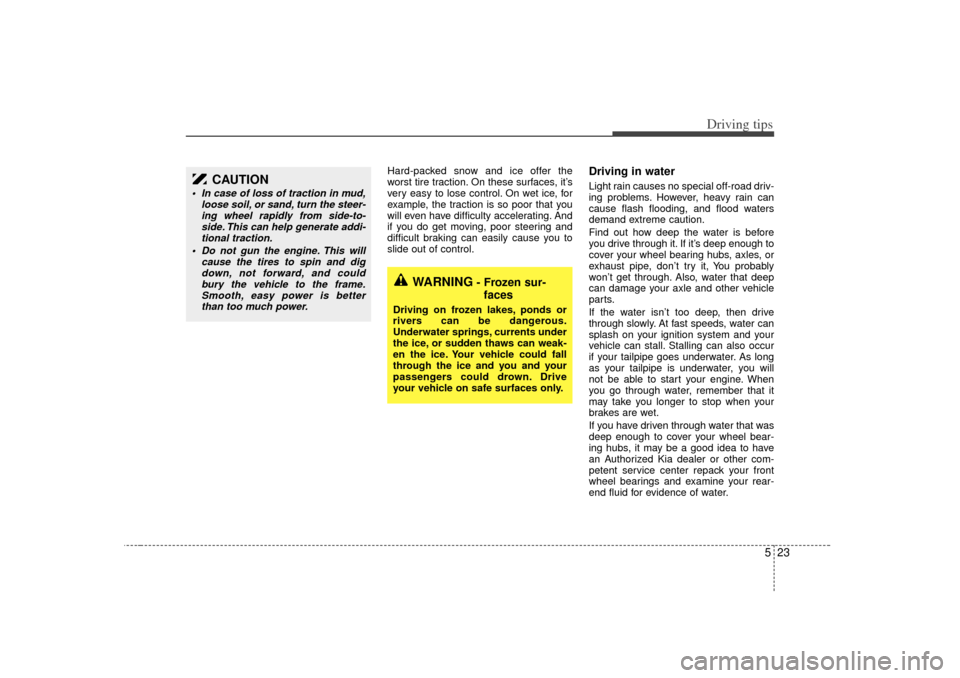
523
Driving tips
Hard-packed snow and ice offer the
worst tire traction. On these surfaces, it’s
very easy to lose control. On wet ice, for
example, the traction is so poor that you
will even have difficulty accelerating. And
if you do get moving, poor steering and
difficult braking can easily cause you to
slide out of control.
Driving in waterLight rain causes no special off-road driv-
ing problems. However, heavy rain can
cause flash flooding, and flood waters
demand extreme caution.
Find out how deep the water is before
you drive through it. If it’s deep enough to
cover your wheel bearing hubs, axles, or
exhaust pipe, don’t try it, You probably
won’t get through. Also, water that deep
can damage your axle and other vehicle
parts.
If the water isn’t too deep, then drive
through slowly. At fast speeds, water can
splash on your ignition system and your
vehicle can stall. Stalling can also occur
if your tailpipe goes underwater. As long
as your tailpipe is underwater, you will
not be able to start your engine. When
you go through water, remember that it
may take you longer to stop when your
brakes are wet.
If you have driven through water that was
deep enough to cover your wheel bear-
ing hubs, it may be a good idea to have
an Authorized Kia dealer or other com-
petent service center repack your front
wheel bearings and examine your rear-
end fluid for evidence of water.
CAUTION
In case of loss of traction in mud,loose soil, or sand, turn the steer-ing wheel rapidly from side-to-side. This can help generate addi- tional traction.
Do not gun the engine. This will cause the tires to spin and digdown, not forward, and couldbury the vehicle to the frame. Smooth, easy power is betterthan too much power.
WARNING
- Frozen sur-
faces
Driving on frozen lakes, ponds or
rivers can be dangerous.
Underwater springs, currents under
the ice, or sudden thaws can weak-
en the ice. Your vehicle could fall
through the ice and you and your
passengers could drown. Drive
your vehicle on safe surfaces only.
Page 244 of 325
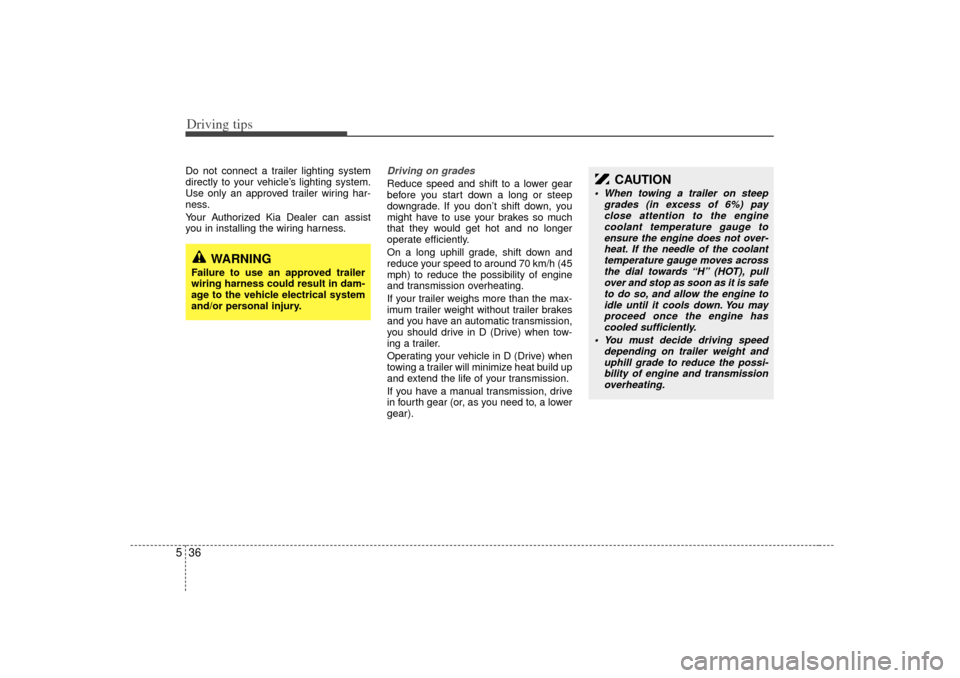
Driving tips36
5Do not connect a trailer lighting system
directly to your vehicle’ s lighting system.
Use only an approved trailer wiring har-
ness.
Your Authorized Kia Dealer can assist
you in installing the wiring harness.
Driving on grades Reduce speed and shift to a lower gear
before you start down a long or steep
downgrade. If you don’t shift down, you
might have to use your brakes so much
that they would get hot and no longer
operate efficiently.
On a long uphill grade, shift down and
reduce your speed to around 70 km/h (45
mph) to reduce the possibility of engine
and transmission overheating.
If your trailer weighs more than the max-
imum trailer weight without trailer brakes
and you have an automatic transmission,
you should drive in D (Drive) when tow-
ing a trailer.
Operating your vehicle in D (Drive) when
towing a trailer will minimize heat build up
and extend the life of your transmission.
If you have a manual transmission, drive
in fourth gear (or, as you need to, a lower
gear).
WARNING
Failure to use an approved trailer
wiring harness could result in dam-
age to the vehicle electrical system
and/or personal injury.
CAUTION
When towing a trailer on steep grades (in excess of 6%) payclose attention to the enginecoolant temperature gauge to ensure the engine does not over-heat. If the needle of the coolanttemperature gauge moves acrossthe dial towards “H” (HOT), pull over and stop as soon as it is safeto do so, and allow the engine toidle until it cools down. You mayproceed once the engine has cooled sufficiently.
You must decide driving speed depending on trailer weight anduphill grade to reduce the possi- bility of engine and transmissionoverheating.
Page 245 of 325
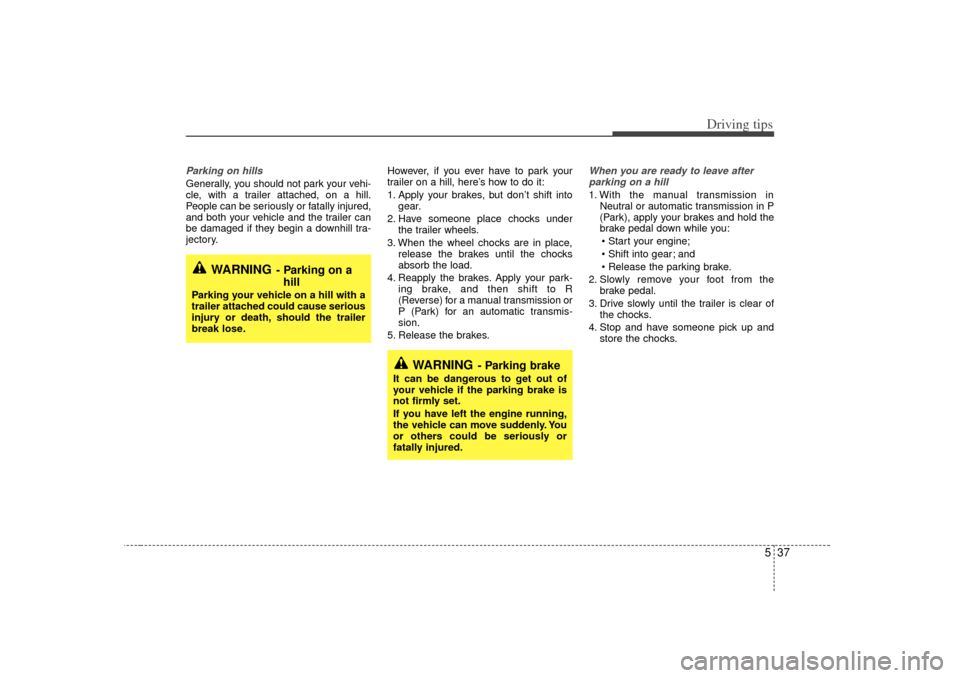
537
Driving tips
Parking on hills Generally, you should not park your vehi-
cle, with a trailer attached, on a hill.
People can be seriously or fatally injured,
and both your vehicle and the trailer can
be damaged if they begin a downhill tra-
jectory.However, if you ever have to park your
trailer on a hill, here
’s how to do it:
1. Apply your brakes, but don’t shift into gear.
2. Have someone place chocks under the trailer wheels.
3. When the wheel chocks are in place, release the brakes until the chocks
absorb the load.
4. Reapply the brakes. Apply your park- ing brake, and then shift to R
(Reverse) for a manual transmission or
P (Park) for an automatic transmis-
sion.
5. Release the brakes.
When you are ready to leave after parking on a hill 1. With the manual transmission in Neutral or automatic transmission in P
(Park), apply your brakes and hold the
brake pedal down while you:
Start your engine;
Shift into gear; and
Release the parking brake.
2. Slowly remove your foot from the brake pedal.
3. Drive slowly until the trailer is clear of the chocks.
4. Stop and have someone pick up and store the chocks.
WARNING
- Parking brake
It can be dangerous to get out of
your vehicle if the parking brake is
not firmly set.
If you have left the engine running,
the vehicle can move suddenly. You
or others could be seriously or
fatally injured.
WARNING
- Parking on ahill
Parking your vehicle on a hill with a
trailer attached could cause serious
injury or death, should the trailer
break lose.
Page 246 of 325

Driving tips38
5Maintenance when trailer towing Your vehicle will need service more often
when you regularly pull a trailer.
Important items to pay particular atten-
tion to include engine oil, automatic
transmission fluid, axle lubricant and
cooling system fluid. Brake condition is
another important item to frequently
check. Each item is covered in this man-
ual, and the Index will help you find them
quickly. If you’ re trailering, it ’s a good idea
to review these sections before you start
your trip.
Don’t forget to also maintain your trailer
and hitch. Follow the maintenance
schedule that accompanied your trailer
and check it periodically. Preferably, con-
duct the check at the start of each day’ s
driving. Most importantly, all hitch nuts
and bolts should be tight.
CAUTION
Due to higher load during trailer usage, overheating might occurin hot days or during uphill driv-ing. If the coolant gauge indicates over-heating, switch off the A/Cand stop the vehicle in a safe areato cool down the engine.
When towing check transmission fluid more frequently.
If your vehicle is not equipped with the air conditioner, youshould install a condenser fan to improve engine performancewhen towing a trailer.